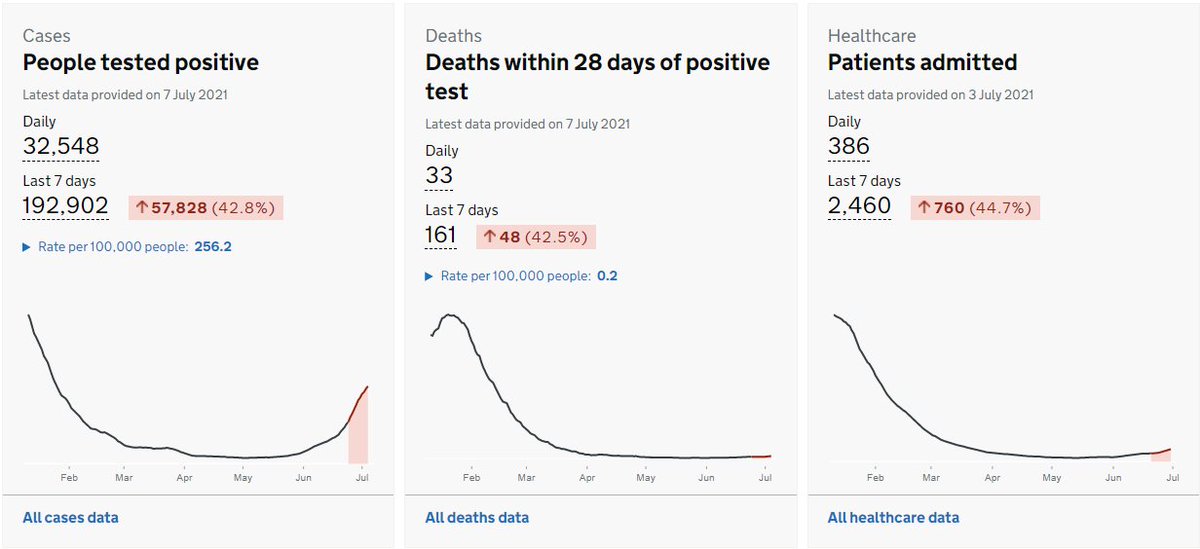
I feel the need to clarify my argument against delaying Step 4, because I think the nuance may be getting lost. For me at least, it’s not a case of “let’s have lots of infections now because it will make things better in the winter, and the net effect will be positive”.
To say that would imply much greater confidence about how the epidemic will evolve over the next several months than I actually have. Rather, it’s more the reverse: “I’m not confident that delay (of Step 4 to September) will make things better, overall”
I can readily construct scenarios where delay *does* make things better, via the right combination of extra vaccination, combined with slow/gradual removal of residual controls. The summer is slightly improved, and there is no large winter/spring wave, so the net effect is good.
BUT I can also easily construct scenarios where we do get a further wave in the winter/spring, with the impact of extra vaccination being offset by seasonality, by mixing in schools and universities, and possibly by gradually reducing compliance with ongoing restrictions.
And those scenarios tend to be worse if we have a smaller summer wave (because of less immunity carried forward), and quite often the net overall effect is also negative, because of the impact of “overshoot” in that winter/spring wave.
We also face risks, not included in my model, from new variants and from waning immunity, which could increase the risk level in this period – and again, these risks will be more severe if we have a larger “immunity gap” still to cover.
So, overall, I’m quite unsure as to whether delay would make things better or worse – it could go either way, depending on what else happens. And while some of those factors are controllable, others are not (or not easily) e.g. new variants, and public levels of compliance.
Hence for me, to be confident delay was the right policy would require either:
a) A strong focus on short-term outcomes, and discounting of what may happen in the future, or
b) A belief that the longer term will be OK because the power of vaccinations (inc boosters) will win out
a) A strong focus on short-term outcomes, and discounting of what may happen in the future, or
b) A belief that the longer term will be OK because the power of vaccinations (inc boosters) will win out
…and we won’t be thrown too far off course by new variants / waning immunity / other risks.
In that latter case, it’s a more optimistic mindset– and those opposing delay are taking a more cynical and defeatist approach, or a more realistic one, depending on your point of view.
In that latter case, it’s a more optimistic mindset– and those opposing delay are taking a more cynical and defeatist approach, or a more realistic one, depending on your point of view.
I think at the heart of this lies a debate about burden of proof in the face of uncertainty. If we’re given a series of options and aren’t sure which leads to the best medical and economic outcomes, should we:
a)Delay until we can choose with more confidence?
...
a)Delay until we can choose with more confidence?
...
b) Pick the option with the best short-term outcomes in the hope/expectation we can find ways to improve the longer-term position later on?
c) Pick the option with the fewest restrictions on people’s liberty, on the grounds that maintaining these requires a very compelling case?
c) Pick the option with the fewest restrictions on people’s liberty, on the grounds that maintaining these requires a very compelling case?
I’m probably in the latter camp on this particular decision (I reserve the right to think differently on others!), but I can see and respect the arguments for different approaches. Rational, well-meaning people are going to disagree on this, unfortunately.
Another way of thinking about this is: imagine (scary thought!) you were put in charge of the government’s covid policy for 2 months, but after that you pass it on to someone else, and have no further influence on what happens. What relative weight…
…should you give in your decision-making to:
a) Improving covid and other outcomes during the period you are in charge?
b) Handing on a “good” situation to your successor – which ideally would include both low case rates, and high levels of built-up immunity?
a) Improving covid and other outcomes during the period you are in charge?
b) Handing on a “good” situation to your successor – which ideally would include both low case rates, and high levels of built-up immunity?
In other words, should you optimise the short term, and trust your successors will find ways to deal with any problems that you leave for them? Or should you seek to improve the long-term position, even at the cost of more short-term pain – which could later prove to be wasted?
I genuinely don’t think there’s an easy or right answer to that question – it’s all about a balance of risks, some of which are impossible to quantify with any accuracy. And which is why this is hard, and why sane, intelligent people are going to disagree on the best approach.
/end!
PS for those new to the debate, here is a link to yesterday's thread:
https://twitter.com/JamesWard73/status/1413834989209272321?s=20
• • •
Missing some Tweet in this thread? You can try to
force a refresh















